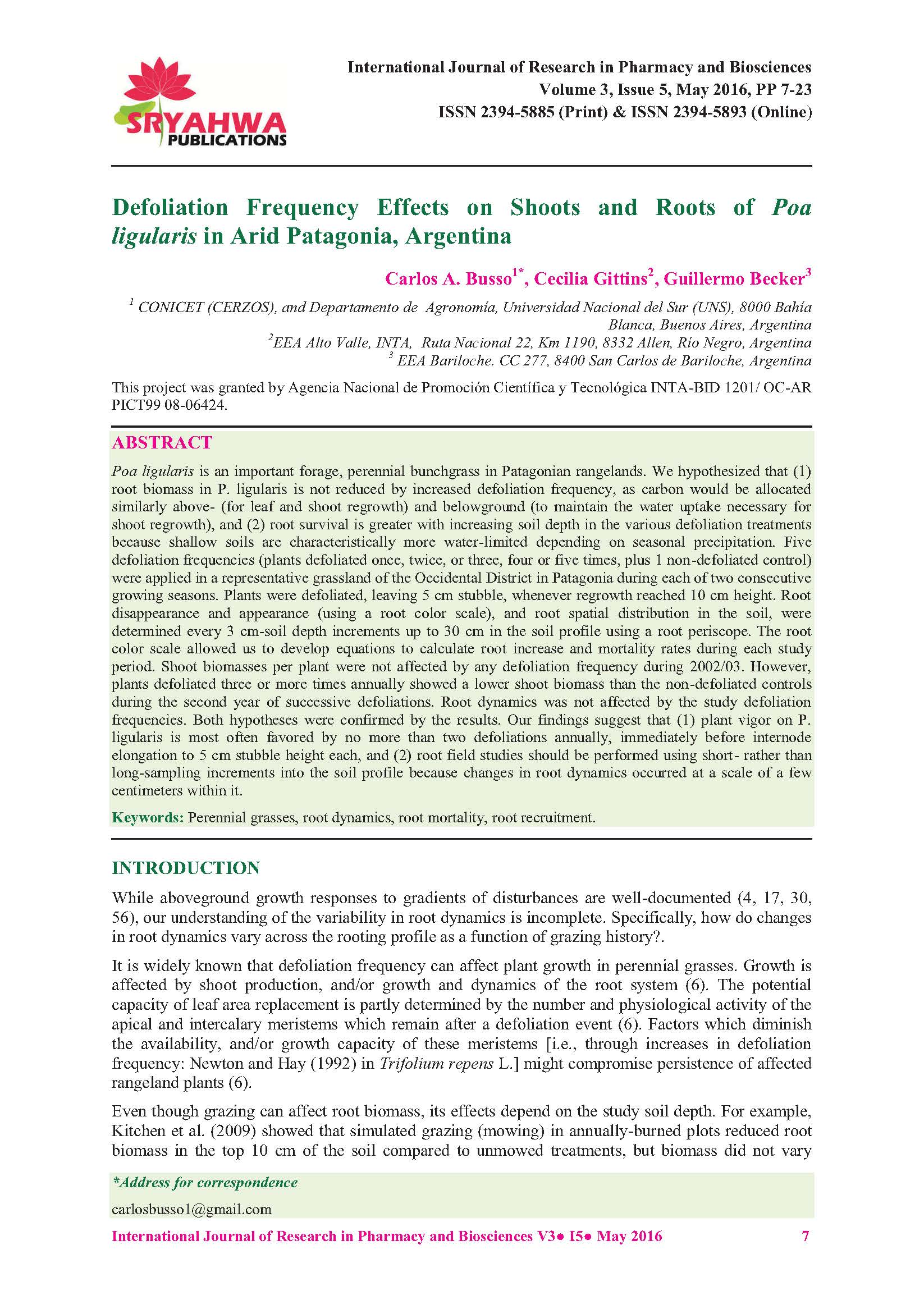Ver ítem
- xmlui.general.dspace_homeCentros Regionales y EEAsCentro Regional Patagonia NorteEEA Alto ValleArtículos científicosxmlui.ArtifactBrowser.ItemViewer.trail
- Inicio
- Centros Regionales y EEAs
- Centro Regional Patagonia Norte
- EEA Alto Valle
- Artículos científicos
- Ver ítem
Defoliation Frequency Effects on Shoots and Roots of Poa ligularis in Arid Patagonia, Argentina
Resumen
Poa ligularis is an important forage, perennial bunchgrass in Patagonian rangelands. We hypothesized that (1) root biomass in P. ligularis is not reduced by increased defoliation frequency, as carbon would be allocated similarly above- (for leaf and shoot regrowth) and belowground (to maintain the water uptake necessary for shoot regrowth), and (2) root survival is greater with increasing soil depth in the various defoliation treatments because shallow
[ver mas...]
Poa ligularis is an important forage, perennial bunchgrass in Patagonian rangelands. We hypothesized that (1) root biomass in P. ligularis is not reduced by increased defoliation frequency, as carbon would be allocated similarly above- (for leaf and shoot regrowth) and belowground (to maintain the water uptake necessary for shoot regrowth), and (2) root survival is greater with increasing soil depth in the various defoliation treatments because shallow soils are characteristically more water-limited depending on seasonal precipitation. Five defoliation frequencies (plants defoliated once, twice, or three, four or five times, plus 1 non-defoliated control) were applied in a representative grassland of the Occidental District in Patagonia during each of two consecutive growing seasons. Plants were defoliated, leaving 5 cm stubble, whenever regrowth reached 10 cm height. Root disappearance and appearance (using a root color scale), and root spatial distribution in the soil, were determined every 3 cm-soil depth increments up to 30 cm in the soil profile using a root periscope. The root color scale allowed us to develop equations to calculate root increase and mortality rates during each study period. Shoot biomasses per plant were not affected by any defoliation frequency during 2002/03. However, plants defoliated three or more times annually showed a lower shoot biomass than the non-defoliated controls during the second year of successive defoliations. Root dynamics was not affected by the study defoliation frequencies. Both hypotheses were confirmed by the results. Our findings suggest that (1) plant vigor on P. ligularis is most often favored by no more than two defoliations annually, immediately before internode elongation to 5 cm stubble height each, and (2) root field studies should be performed using short- rather than long-sampling increments into the soil profile because changes in root dynamics occurred at a scale of a few centimeters within it.
[Cerrar]

Autor
Busso, Carlos Alberto;
Gittins Lopez, Cecilia Gabriela;
Becker, Guillermo Fernando;
Fuente
International Journal of Research in Pharmacy and Biosciences 3 (5) : 7-23 (Mayo 2016)
Fecha
2016
Editorial
Sryahwa Publications
ISSN
2394-5885 (Print)
2394-5893 (Online)
2394-5893 (Online)
Formato
pdf
Tipo de documento
artículo
Palabras Claves
Derechos de acceso
Abierto
 Excepto donde se diga explicitamente, este item se publica bajo la siguiente descripción: Creative Commons Attribution-NonCommercial-ShareAlike 2.5 Unported (CC BY-NC-SA 2.5)
Excepto donde se diga explicitamente, este item se publica bajo la siguiente descripción: Creative Commons Attribution-NonCommercial-ShareAlike 2.5 Unported (CC BY-NC-SA 2.5)


